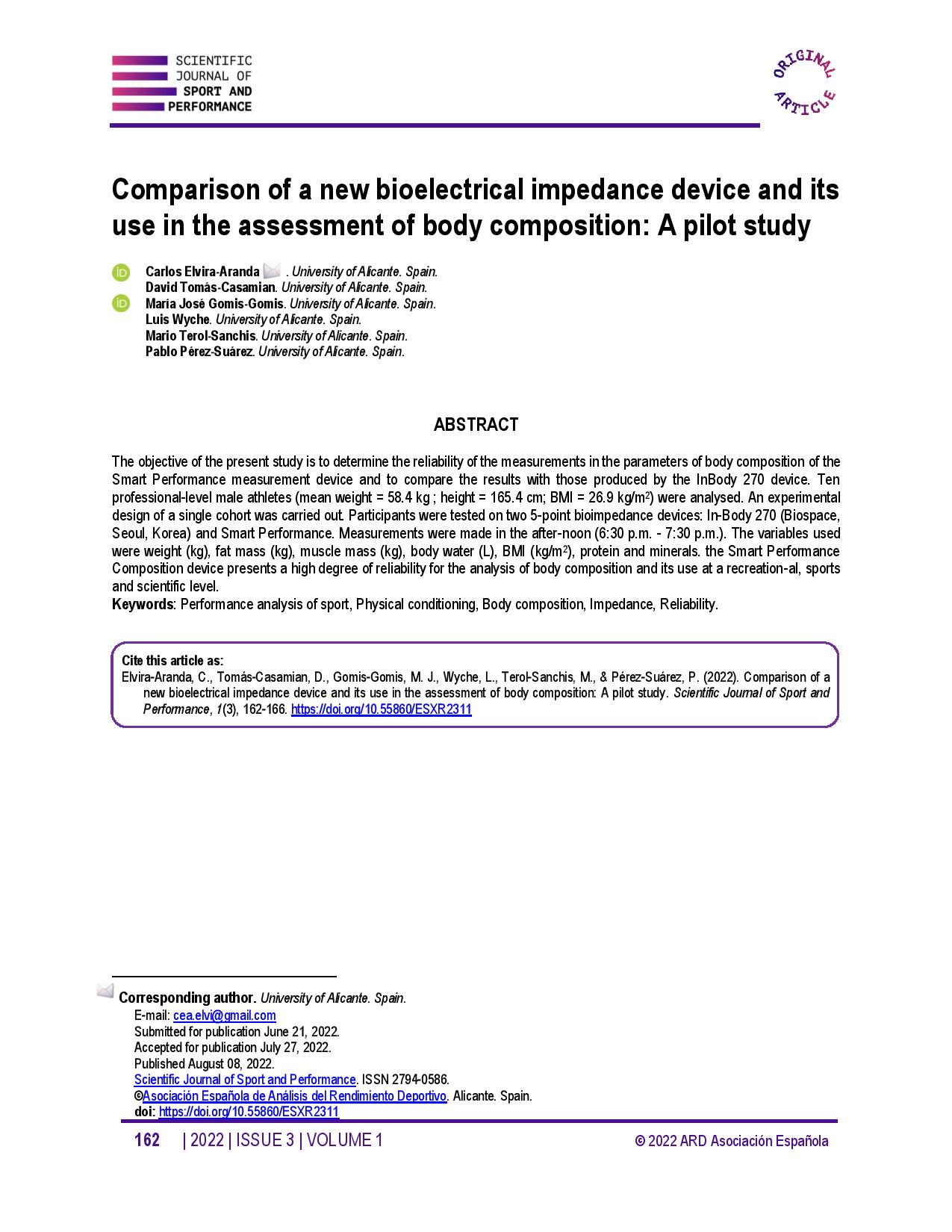Comparison of a new bioelectrical impedance device and its use in the assessment of body composition A pilot study
Main Article Content
Abstract
The objective of the present study is to determine the reliability of the measurements in the parameters of body composition of the Smart Performance measurement device and to compare the results with those produced by the InBody 270 device. Ten professional-level male athletes (mean weight = 58.4 kg ; height = 165.4 cm; BMI = 26.9 kg/m2) were analysed. An experimental design of a single cohort was carried out. Participants were tested on two 5-point bioimpedance devices: In-Body 270 (Biospace, Seoul, Korea) and Smart Performance. Measurements were made in the after-noon (6:30 p.m. - 7:30 p.m.). The variables used were weight (kg), fat mass (kg), muscle mass (kg), body water (L), BMI (kg/m2), protein and minerals. the Smart Performance Composition device presents a high degree of reliability for the analysis of body composition and its use at a recreation-al, sports and scientific level.
Article Details

This work is licensed under a Creative Commons Attribution-NonCommercial-ShareAlike 4.0 International License.
References
Becerra, C., Reigal, R., Hernández-Mendo, A. and Martín-Tamayo, I. (2013). Relationship of physical fitness and body composition with self-rated health. RICYDE, 9(9), 305-318. https://doi.org/10.5232/ricyde2013.03401 DOI: https://doi.org/10.5232/ricyde2013.03401
Campa, F., Toselli, S., Mazzilli, M., Gobbo, L. A., & Coratella, G. (2021). Assessment of Body Composition in Athletes: A Narrative Review of Available Methods with Special Reference to Quantitative and Qualitative Bioimpedance Analysis. Nutrients, 13(5), 1620. https://doi.org/10.3390/nu13051620 DOI: https://doi.org/10.3390/nu13051620
Chamney, P. W., Krämer, M., Rode, C., Kleinekofort, W., & Wizemann, V. (2002). A new technique for establishing dry weight in hemodialysis patients via whole body bioimpedance. Kidney International, 61(6), 2250–2258. https://doi.org/10.1046/j.1523-1755.2002.00377.x DOI: https://doi.org/10.1046/j.1523-1755.2002.00377.x
Costa, O., Alonso-Aubin, D., Potrocinio de Oliveira, C., Candia-Luján, R. and de Paz, J. (2015). Métodos de evaluación de la composición corporal: una revisión actualizada de descripción, aplicación, ventajas y desventajas. Archivos de Medicina del Deporte, 32(6), 387-394. https://doi.org/10.24310/riccafd.2017.v6i3.6132 DOI: https://doi.org/10.24310/riccafd.2017.v6i3.6132
Larsen, M. N., Krustrup, P., Araújo Póvoas, S. C., & Castagna, C. (2021). Accuracy and reliability of the InBody 270 multi-frequency body composition analyser in 10-12-year-old children. PloS One, 16(3), e0247362. https://doi.org/10.1371/journal.pone.0247362 DOI: https://doi.org/10.1371/journal.pone.0247362
Leiva, A.M., Martínez, M.A., Cristi-Montero, C., Salas, C., Ramírez-Campillo, R., Díaz Martínez, X., Aguilar-Farías, N. and Celis-Morales, C.. (2017). El sedentarismo se asocia a un incremento de factores de riesgo cardiovascular y metabólicos independiente de los niveles de actividad física. Revista médica de Chile, 145(4), 458-467. https://doi.org/10.4067/s0034-98872017000400006 DOI: https://doi.org/10.4067/S0034-98872017000400006
Malina R. M. (2007). Body composition in athletes: assessment and estimated fatness. Clinics in sports medicine, 26(1), 37–68. https://doi.org/10.1016/j.csm.2006.11.004 DOI: https://doi.org/10.1016/j.csm.2006.11.004
Toselli S. (2021). Body Composition and Physical Health in Sports Practice: An Editorial. International Journal of Environmental Research and Public Health, 18(9), 4534. https://doi.org/10.3390/ijerph18094534 DOI: https://doi.org/10.3390/ijerph18094534
Mascherini, G., Petri, C., Ermini, E., Bini, V., Calà, P., Galanti, G., & Modesti, P. A. (2019). Overweight in Young Athletes: New Predictive Model of Overfat Condition. International Journal of Environmental Research and Public Health, 16(24), 5128. https://doi.org/10.3390/ijerph16245128 DOI: https://doi.org/10.3390/ijerph16245128
Mendoza-Muñoz, M., Adsuar, J. C., Pérez-Gómez, J., Muñoz-Bermejo, L., Garcia-Gordillo, M. Á., & Carlos-Vivas, J. (2020). Influence of Body Composition on Physical Fitness in Adolescents. Medicina, 56(7), 328. https://doi.org/10.3390/medicina56070328 DOI: https://doi.org/10.3390/medicina56070328
Ortega, F. B., Ruiz, J. R., Castillo, M. J., & Sjöström, M. (2008). Physical fitness in childhood and adolescence: a powerful marker of health. International Journal of Obesity, 32(1), 1–11. https://doi.org/10.1038/sj.ijo.0803774 DOI: https://doi.org/10.1038/sj.ijo.0803774
Sundgot-Borgen, J., & Torstveit, M. K. (2010). Aspects of disordered eating continuum in elite high-intensity sports. Scandinavian Journal of Medicine & Science in Sports, 20(2), 112–121. https://doi.org/10.1111/j.1600-0838.2010.01190.x DOI: https://doi.org/10.1111/j.1600-0838.2010.01190.x




